Andrew Cartmel's Blog, page 43
December 16, 2012
‘Jane explained’: the literary genius of Philip MacDonald
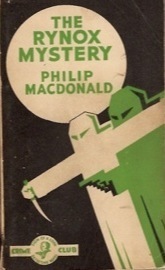 My personal Philip MacDonald literary festival continues. This writer is proving so terrific I just bought another one of his novels: The Rynox Mystery. I will read it and report back.
My personal Philip MacDonald literary festival continues. This writer is proving so terrific I just bought another one of his novels: The Rynox Mystery. I will read it and report back.I just finished reading Patrol (see earlier posts) and I’m seriously impressed.
Patrol kept surprising me, right up until the end. I couldn’t guess what was going to happen, and there were at least two sequences of enormous suspense. Interspersed with violent action, brutal surprises and — for my taste — just a little too much colourful characterisation.
A riveting read.
Any downsides? Well, I suppose you could argue it was borderline racist now and then. But those soldiers, in those days, would have held exactly those attitudes.
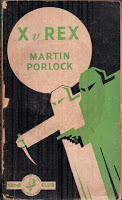 Plus wouldn’t you be a little ticked off by a wily invisible foe who was slaughtering your comrades, one by one? Unacceptable language might creep forth now and then.
Plus wouldn’t you be a little ticked off by a wily invisible foe who was slaughtering your comrades, one by one? Unacceptable language might creep forth now and then.A worse sin was MacDonald’s insistence on spelling dialect voices phonetically.Plus… the annoying habit… of using… too many… ellipses… which are those three little dots…
But as far as I can see, none of these imperfections mar X v Rexwritten some five years later. Which I’m currently reading. And which is a cracker.
In fact I’m on page 99 and I’ve just come across a great piece of writing. It’s two words.
Jane explained.
And with those two words, Philip MacDonald (writing here under the pen name Martin Porlock) has saved acres and acres of exposition.
It’s a tiny genuine flash of pure writing genius.
A true craftsman at work.
Published on December 16, 2012 08:54
December 9, 2012
Philip MacDonald
Last week I posted about Patrol (aka The Lost Patrol) by Philip MacDonald. Well I’m happy to report that the book is absolutely not proving a disappointment. It’s terse, violent, engrossing and brilliantly written.
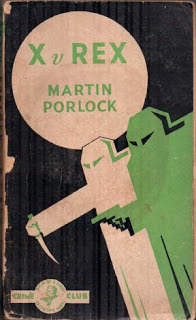
The only reason I haven’t finished it yet is that it’s my public transport book. I keep it in the pocket of my coat, to read on buses and trains.
I’ve done a bit of research on MacDonald and found that he wrote under a number of pseudonyms. One of his most notable novels was the seminal account of a serial killer — many decades before that term was coined — X versus Rex, penned as by Martin Porlock (a Kubla Khan reference, I suspect) about a mysterious murderer who targets policemen.
Well, I had to get hold of that, and thanks to eBay I now have. My copy is illustrated here, with the great generic Collins Crime Club cover. Somebody should make a tee shirt out of it.
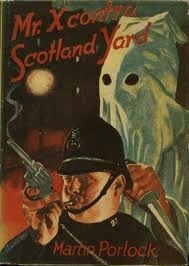 This second MacDonald book is also proving engrossing and readable — and it seems to have been as influential in its own way as Patrol, reprinted numerous times under various titles and filmed at least twice. Philip MacDonald is turning out to be a real find.
This second MacDonald book is also proving engrossing and readable — and it seems to have been as influential in its own way as Patrol, reprinted numerous times under various titles and filmed at least twice. Philip MacDonald is turning out to be a real find.
My only complaint about his writing so far is that he insists on spelling out accents phonetically in dialogue. So, for instance, instead of saying “with all due respect”, his Cockney soldier says “wiv all joo respeck”.
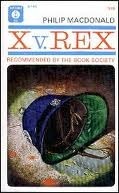 This is a really tedious habit. It has flatly prevented me from reading, for example, Clarence Mulford’s Hopalong Cassidy stories and all of John Creasey’s Westerns (for some reason, cowboy stories seem particularly prone to this aberration).
This is a really tedious habit. It has flatly prevented me from reading, for example, Clarence Mulford’s Hopalong Cassidy stories and all of John Creasey’s Westerns (for some reason, cowboy stories seem particularly prone to this aberration).
Other than Philip MacDonald, the only other really good writer I know who indulged in this solecism is George MacDonald Fraser, creator of Flashman. But, as with Philip MacDonald, I can endure it in Fraser’s writing.
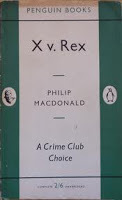 I suspect this is not so much because they do it better, but just because their writing is of such a high calibre in every other respect that I am willing to forgive them this one lapse.
I suspect this is not so much because they do it better, but just because their writing is of such a high calibre in every other respect that I am willing to forgive them this one lapse.
Don’t try it at home, though. I recently took part in a panel called ‘How NOT to Write’. And one of our major pieces of advice was never to spell out your characters’ accents phonetically in dialogue.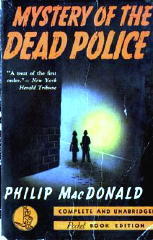 (Picture information. Other than using the eBay image for the copy of X v Rex which I recently bought, I have also borrowed images from two brilliant crime writing websites: Tipping My Fedora and Mystery File and the equally excellent more general pop fiction site Existential Ennui. They are all well worth a visit. Thanks, gents.)
(Picture information. Other than using the eBay image for the copy of X v Rex which I recently bought, I have also borrowed images from two brilliant crime writing websites: Tipping My Fedora and Mystery File and the equally excellent more general pop fiction site Existential Ennui. They are all well worth a visit. Thanks, gents.)


The only reason I haven’t finished it yet is that it’s my public transport book. I keep it in the pocket of my coat, to read on buses and trains.
I’ve done a bit of research on MacDonald and found that he wrote under a number of pseudonyms. One of his most notable novels was the seminal account of a serial killer — many decades before that term was coined — X versus Rex, penned as by Martin Porlock (a Kubla Khan reference, I suspect) about a mysterious murderer who targets policemen.
Well, I had to get hold of that, and thanks to eBay I now have. My copy is illustrated here, with the great generic Collins Crime Club cover. Somebody should make a tee shirt out of it.
 This second MacDonald book is also proving engrossing and readable — and it seems to have been as influential in its own way as Patrol, reprinted numerous times under various titles and filmed at least twice. Philip MacDonald is turning out to be a real find.
This second MacDonald book is also proving engrossing and readable — and it seems to have been as influential in its own way as Patrol, reprinted numerous times under various titles and filmed at least twice. Philip MacDonald is turning out to be a real find.My only complaint about his writing so far is that he insists on spelling out accents phonetically in dialogue. So, for instance, instead of saying “with all due respect”, his Cockney soldier says “wiv all joo respeck”.
 This is a really tedious habit. It has flatly prevented me from reading, for example, Clarence Mulford’s Hopalong Cassidy stories and all of John Creasey’s Westerns (for some reason, cowboy stories seem particularly prone to this aberration).
This is a really tedious habit. It has flatly prevented me from reading, for example, Clarence Mulford’s Hopalong Cassidy stories and all of John Creasey’s Westerns (for some reason, cowboy stories seem particularly prone to this aberration).Other than Philip MacDonald, the only other really good writer I know who indulged in this solecism is George MacDonald Fraser, creator of Flashman. But, as with Philip MacDonald, I can endure it in Fraser’s writing.
 I suspect this is not so much because they do it better, but just because their writing is of such a high calibre in every other respect that I am willing to forgive them this one lapse.
I suspect this is not so much because they do it better, but just because their writing is of such a high calibre in every other respect that I am willing to forgive them this one lapse.Don’t try it at home, though. I recently took part in a panel called ‘How NOT to Write’. And one of our major pieces of advice was never to spell out your characters’ accents phonetically in dialogue.
 (Picture information. Other than using the eBay image for the copy of X v Rex which I recently bought, I have also borrowed images from two brilliant crime writing websites: Tipping My Fedora and Mystery File and the equally excellent more general pop fiction site Existential Ennui. They are all well worth a visit. Thanks, gents.)
(Picture information. Other than using the eBay image for the copy of X v Rex which I recently bought, I have also borrowed images from two brilliant crime writing websites: Tipping My Fedora and Mystery File and the equally excellent more general pop fiction site Existential Ennui. They are all well worth a visit. Thanks, gents.)
Published on December 09, 2012 03:47
December 2, 2012
The Lost Patrol
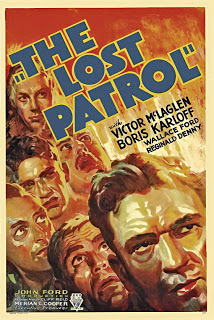 I’ve discovered a rather amazing book by Philip MacDonald.
I’ve discovered a rather amazing book by Philip MacDonald. And it’s all thanks to an insightful and informative article by Kim Newman in the film magazine Sight & Sound.
In the July 2012 issue on page 28, in a piece on Ridley Scott’s Prometheus, Kim discusses the basic scenario of Alien, Aliens, Predator and literally hundreds of other films — “western, war, action, adventure, jungle, horror and science fiction” and suggests that we should call them ‘lost patrol’ films.
Because “The plot about a unit separated from a home base — picked off one by one by a mostly unseen enemy and riven by tensions within the group that make one or more of the men as much a danger as the external opponent — goes back to Philip MacDonald’s 1927 novel Patrol set in Mesopotamia (yes, modern day Iraq) during World War I and drawn from the author’s personal experiences.”
Well, as soon as I read that, I had to get hold of a copy of the Lost Patrol. Which was easier said than done. Because, for such an influential classic, the book is startlingly scarce and difficult to find. It hasn’t been reprinted for decades.
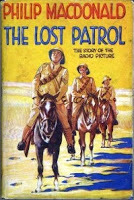 After months of searching I finally came up with a decent copy on eBay at a reasonable price. It’s a nice little pocket sized hardcover, a rather sleazy cheap reprint of the day — a movie tie-in, in fact — complete with ads at the front and back (self improvement correspondence courses and snake-oil horoscope astrology).
After months of searching I finally came up with a decent copy on eBay at a reasonable price. It’s a nice little pocket sized hardcover, a rather sleazy cheap reprint of the day — a movie tie-in, in fact — complete with ads at the front and back (self improvement correspondence courses and snake-oil horoscope astrology).I’ve only started reading it, but I’m already gripped and impressed. Here’s a quote from the very first page:
“I don’t exactly know,” said the Sergeant half aloud, “what to do with him.”The head which rested on his knee shifted a little and a froth of blood bubbled suddenly at the corners of the mouth…The Corporal who stood beside him knelt, peering at the face on the Sergeant’s knee. “That’s that!” he said…
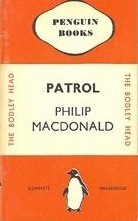 “Yes. Pity. Decent boy in some ways. No soldier.” He gently eased down the body until it lay flat upon the sand.
“Yes. Pity. Decent boy in some ways. No soldier.” He gently eased down the body until it lay flat upon the sand.What a great opening!
It gets better. We learn that the dead soldier, rather cruelly nicknamed ‘Muriel’ was in fact their commanding officer. And the incompetence of this inexperienced young toff has left the patrol stuck in a desperate and dangerous situation.
There are several important things to note about MacDonald’s writing, which are very obvious even on this brief acquaintance.
It’s amazingly modern. There is no mucking about. No lengthy scene setting or enumeration of character. We are straight into the story, by way of dialogue, in a terse clear prose which is hardboiled and stripped down in the manner of Hemingway and Hammett — yet written at a time when those writers were themselves just getting started.
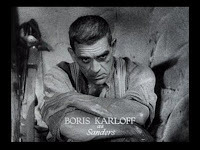 And it’s intensely cinematic. Effectively the story starts with a close up of the dying officer.
And it’s intensely cinematic. Effectively the story starts with a close up of the dying officer.It’s hardly surprising that the book was filmed twice, shortly after it was published and has been constantly remade, officially and unofficially, ever since.
Nor is it surprising that Philip MacDonald ended up in Hollywood. Indeed, I was already familiar with his writing from The List of Adrian Messenger, a taut and cynical little thriller which was turned into a film by John Huston.
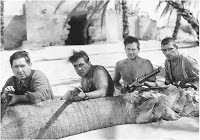 It’s always dangerous to make judgements on a book before you finished reading it so I’ll update this post if The Lost Patrol takes a nose dive and turns out to be a major disappointment.
It’s always dangerous to make judgements on a book before you finished reading it so I’ll update this post if The Lost Patrol takes a nose dive and turns out to be a major disappointment.But I rather suspect it won’t.
Thanks for the tip, Kim.
(Picture credits: the Penguin cover is from an excellent Penguin blog Travellin' Penguin. The Literary Press cover shot is from Amazon, courtesy of M. Welfare. The Karloff pic is from the Land of Cerpts and Honey blog. The group shot pic is from the John Ford blog The Skeins. The movie poster is from Share TV.)
Published on December 02, 2012 04:09
November 11, 2012
The Undercarriage of the F22
I recently had lunch with a friend.

He paid, which was nice.
What was even nicer was that he had read my spy thriller Operation Herod.
“There is just one problem with it,” he said tactfully. “That jet fighter that you mentioned? It could never be used on an aircraft carrier. You see, it’s an F22.”
I said this was fascinating, and useful. I also observed that he’d had a copy of the manuscript for three years, and it would have been even more fascinating and useful if he could have pointed out this solecism before publication.
But what the heck.
My friend went on, “All US carriers currently fly the F18, in the future theirs — and ours — will fly the F35, but the F22 will never be carrier-compatible.”
 Apparently there were all kinds of problems with the sexy fighter jet I had chosen for my sexy CIA operative and former Marine pilot Minerva Caine to fly on a mission with Rupert Hood.
Apparently there were all kinds of problems with the sexy fighter jet I had chosen for my sexy CIA operative and former Marine pilot Minerva Caine to fly on a mission with Rupert Hood.
Although I had correctly given the jet an arresting hook, which it would need for an aircraft carrier landing, this was not sufficient to make it carrier compatible.
F22s do have such hooks, but they are only used on land airstrips, in emergencies, to stop the planes at the end of the runway. The F22 doesn’t have the heavier structure undercarriage needed to survive the stresses of a carrier landing.
There are all sorts of other problems with adapting a jet for carrier work. The engine intakes have to be customized to avoid corrosion damage from salt water, for instance.
I know all that now, thanks to my friend. “I am sorry to be so irritatingly pedantic about aircraft carriers,” he said. “I hope you’re not annoyed by the correction.” Not at all, I said. I wasn’t put out. On the contrary, I got a kick out of it.
Not at all, I said. I wasn’t put out. On the contrary, I got a kick out of it.
While I wouldn’t dare to compare myself to the great Ian Fleming (I could never smoke all those cigarettes, for a start), this episode nonetheless gave me a little thrill because it reminded me so clearly of Fleming being taken to task by weapons expert Geoffrey Boothroyd for giving Bond the wrong kind of gun.
If anybody else spots factual errors in the Rupert Hood books (or indeed in today's blog post), please get in touch and I’ll try and correct them in later editions.
Meanwhile, enjoy the pictures of the F22 (from Defense Industry Daily), the F18 (Wikipedia) and the F35 (The World of Aeronautics blog).

He paid, which was nice.
What was even nicer was that he had read my spy thriller Operation Herod.
“There is just one problem with it,” he said tactfully. “That jet fighter that you mentioned? It could never be used on an aircraft carrier. You see, it’s an F22.”
I said this was fascinating, and useful. I also observed that he’d had a copy of the manuscript for three years, and it would have been even more fascinating and useful if he could have pointed out this solecism before publication.
But what the heck.
My friend went on, “All US carriers currently fly the F18, in the future theirs — and ours — will fly the F35, but the F22 will never be carrier-compatible.”
 Apparently there were all kinds of problems with the sexy fighter jet I had chosen for my sexy CIA operative and former Marine pilot Minerva Caine to fly on a mission with Rupert Hood.
Apparently there were all kinds of problems with the sexy fighter jet I had chosen for my sexy CIA operative and former Marine pilot Minerva Caine to fly on a mission with Rupert Hood.Although I had correctly given the jet an arresting hook, which it would need for an aircraft carrier landing, this was not sufficient to make it carrier compatible.
F22s do have such hooks, but they are only used on land airstrips, in emergencies, to stop the planes at the end of the runway. The F22 doesn’t have the heavier structure undercarriage needed to survive the stresses of a carrier landing.
There are all sorts of other problems with adapting a jet for carrier work. The engine intakes have to be customized to avoid corrosion damage from salt water, for instance.
I know all that now, thanks to my friend. “I am sorry to be so irritatingly pedantic about aircraft carriers,” he said. “I hope you’re not annoyed by the correction.”
 Not at all, I said. I wasn’t put out. On the contrary, I got a kick out of it.
Not at all, I said. I wasn’t put out. On the contrary, I got a kick out of it.While I wouldn’t dare to compare myself to the great Ian Fleming (I could never smoke all those cigarettes, for a start), this episode nonetheless gave me a little thrill because it reminded me so clearly of Fleming being taken to task by weapons expert Geoffrey Boothroyd for giving Bond the wrong kind of gun.
If anybody else spots factual errors in the Rupert Hood books (or indeed in today's blog post), please get in touch and I’ll try and correct them in later editions.
Meanwhile, enjoy the pictures of the F22 (from Defense Industry Daily), the F18 (Wikipedia) and the F35 (The World of Aeronautics blog).
Published on November 11, 2012 03:20
October 29, 2012
Skyfall: Bond Beyond All Expectaion
In Skyfall Albert Finney plays the only grizzled old gamekeeper in the world who doesn’t know the difference between a rifle and a shotgun.
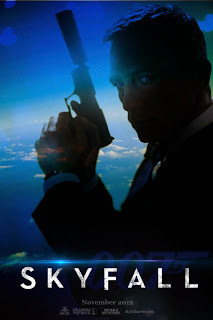 But now I’ve got that annoying solecism off my chest, I have to tell you that Skyfall is a masterpiece.
But now I’ve got that annoying solecism off my chest, I have to tell you that Skyfall is a masterpiece.
If you have a shred of interest in Bond movies, you should drop everything and go and see it right now.
Skyfall is written by the admirable team of Neal Purvis and Robert Wade who have been doing excellent work on the franchise for many years. (They also attended my alma mater, the University of Kent at Canterbury -- hi, guys.)
As has become traditional, the Purvis & Wade script was then rewritten by another hired gun, presumably to provide some additional fresh ideas.
On the previous Daniel Craig Bonds, this third writer was Paul Haggis. This time around it’s John Logan, who wrote Gladiator.
And James Bond was, of course, created by the great Ian Fleming.
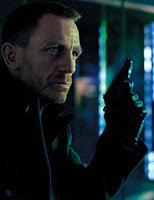 I don’t know how to apportion credit for all the first-rate material in the Skyfall, but suffice to say the writers got it right.
I don’t know how to apportion credit for all the first-rate material in the Skyfall, but suffice to say the writers got it right.
Not just the writers. The cinematography is stunning. And Sam Mendes does a great job of directing.
The Thomas Newman music is the best Bond score in years; he’s new to the franchise and is on board because he’s composed all of Mendes’ films (perhaps most memorably American Beauty).
And the cast is splendid. Albert Finney is splendid – it certainly wasn’t his fault about the rifle dialogue. I suspect it wasn’t the writers’ fault, either. What probably happened was that the script specified a rifle, and then somebody decided a double barrelled shotgun was sexier and changed the prop without adjusting the script.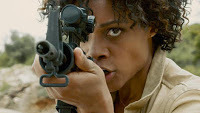 The problem is, both the characters in the shotgun scene are weapons experts. And in a Bond story, guns matter.
The problem is, both the characters in the shotgun scene are weapons experts. And in a Bond story, guns matter.
Other problems with the film? Well, in the initial motorcycle chase the bad guy looks rather too much like Bond (short cropped fair hair) causing confusion about who’s who.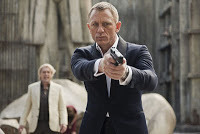 I’m also not convinced about the effects of cyanide as discussed in the film (research continues on this topic).
I’m also not convinced about the effects of cyanide as discussed in the film (research continues on this topic).
And most of all, I’m not happy with the way Bond stalks a sniper and politely waits until the bad guy has murdered his prey before taking action against him.
 But, really, none of that matters at all. Skyfall is a masterpiece.
But, really, none of that matters at all. Skyfall is a masterpiece.
It has a brilliant script.
It has a strikingly hot Bond girl (Naomie Harris, take a bow).
It has a memorable villain, something notably lacking from Quantum of Solace, this time in the shape of Javier Bardem (Javier, I forgive you for Before Night Falls).
 And, praise the gods of espionage thrillers, it has a magnificent climactic action sequence. (Very unusually for a Bond film, moving into Straw Dogs territory.)
And, praise the gods of espionage thrillers, it has a magnificent climactic action sequence. (Very unusually for a Bond film, moving into Straw Dogs territory.)
This last feature was notably lacking from Quantum of Solace (exploding modular hotel, yawn) and most recent Bonds — and indeed most recent American action movies.
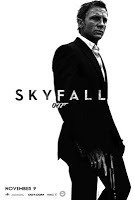 The trend in big screen thrillers has been to open with a slam bang, jaw dropping set piece and then gradually decline to a weak ending (for a recent example, check out the execrable Expendables 2).
The trend in big screen thrillers has been to open with a slam bang, jaw dropping set piece and then gradually decline to a weak ending (for a recent example, check out the execrable Expendables 2).
The terrific action conclusion was beginning to look like a lost art.
Not any more. Skyfall delivers beyond all expectation.
I can’t quite believe I’m saying this, but it’s not just the best Bond movie of the Daniel Craig era…
It’s the best Bond movie of all time.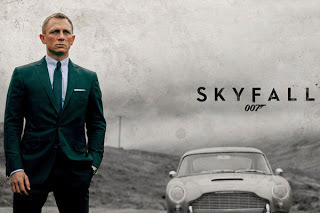

 But now I’ve got that annoying solecism off my chest, I have to tell you that Skyfall is a masterpiece.
But now I’ve got that annoying solecism off my chest, I have to tell you that Skyfall is a masterpiece. If you have a shred of interest in Bond movies, you should drop everything and go and see it right now.
Skyfall is written by the admirable team of Neal Purvis and Robert Wade who have been doing excellent work on the franchise for many years. (They also attended my alma mater, the University of Kent at Canterbury -- hi, guys.)
As has become traditional, the Purvis & Wade script was then rewritten by another hired gun, presumably to provide some additional fresh ideas.
On the previous Daniel Craig Bonds, this third writer was Paul Haggis. This time around it’s John Logan, who wrote Gladiator.
And James Bond was, of course, created by the great Ian Fleming.
 I don’t know how to apportion credit for all the first-rate material in the Skyfall, but suffice to say the writers got it right.
I don’t know how to apportion credit for all the first-rate material in the Skyfall, but suffice to say the writers got it right.Not just the writers. The cinematography is stunning. And Sam Mendes does a great job of directing.
The Thomas Newman music is the best Bond score in years; he’s new to the franchise and is on board because he’s composed all of Mendes’ films (perhaps most memorably American Beauty).
And the cast is splendid. Albert Finney is splendid – it certainly wasn’t his fault about the rifle dialogue. I suspect it wasn’t the writers’ fault, either. What probably happened was that the script specified a rifle, and then somebody decided a double barrelled shotgun was sexier and changed the prop without adjusting the script.
 The problem is, both the characters in the shotgun scene are weapons experts. And in a Bond story, guns matter.
The problem is, both the characters in the shotgun scene are weapons experts. And in a Bond story, guns matter.Other problems with the film? Well, in the initial motorcycle chase the bad guy looks rather too much like Bond (short cropped fair hair) causing confusion about who’s who.
 I’m also not convinced about the effects of cyanide as discussed in the film (research continues on this topic).
I’m also not convinced about the effects of cyanide as discussed in the film (research continues on this topic).And most of all, I’m not happy with the way Bond stalks a sniper and politely waits until the bad guy has murdered his prey before taking action against him.
 But, really, none of that matters at all. Skyfall is a masterpiece.
But, really, none of that matters at all. Skyfall is a masterpiece.It has a brilliant script.
It has a strikingly hot Bond girl (Naomie Harris, take a bow).
It has a memorable villain, something notably lacking from Quantum of Solace, this time in the shape of Javier Bardem (Javier, I forgive you for Before Night Falls).
 And, praise the gods of espionage thrillers, it has a magnificent climactic action sequence. (Very unusually for a Bond film, moving into Straw Dogs territory.)
And, praise the gods of espionage thrillers, it has a magnificent climactic action sequence. (Very unusually for a Bond film, moving into Straw Dogs territory.)This last feature was notably lacking from Quantum of Solace (exploding modular hotel, yawn) and most recent Bonds — and indeed most recent American action movies.
 The trend in big screen thrillers has been to open with a slam bang, jaw dropping set piece and then gradually decline to a weak ending (for a recent example, check out the execrable Expendables 2).
The trend in big screen thrillers has been to open with a slam bang, jaw dropping set piece and then gradually decline to a weak ending (for a recent example, check out the execrable Expendables 2). The terrific action conclusion was beginning to look like a lost art.
Not any more. Skyfall delivers beyond all expectation.
I can’t quite believe I’m saying this, but it’s not just the best Bond movie of the Daniel Craig era…
It’s the best Bond movie of all time.

Published on October 29, 2012 01:25
October 21, 2012
Mr Hood, We're Needed
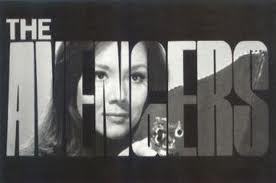 One of the most gratifying things about writing a book is getting feedback.
One of the most gratifying things about writing a book is getting feedback.Okay, wait a minute, to be completely honest the most gratifying thing about writing a book is getting lots of money and sitting in your villa in Tuscany watching the rich colours of the sunset with a glass of vintage wine in your hand and the super model of your choice at your side.
But while you’re waiting for all that, one of the other gratifying things is getting feedback about your books.
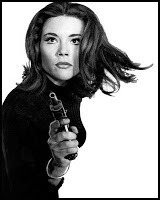 Especially when it's perceptive.
Especially when it's perceptive.Especially when it surprises you.
When I wrote my second Rupert Hood spy thriller, Event Driven, everyone agreed that it was a big improvement on the first. That was good to hear — certainly a lot better than the opposite.
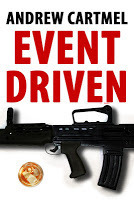 But now that there are two books in the series, people are beginning to see patterns emerge.
But now that there are two books in the series, people are beginning to see patterns emerge.To celebrate delivery of the manuscript I had a drink with my publisher Matt Lynn at the Frontline Club. He grinned at me and said, “Do you know what these stories remind me of? The Avengers. Not the American movie. The vintage Brit TV series.”
I hadn’t thought of this, but he was right. And I was delighted.
Because I loved The Avengers. Particularly the brilliant Diana Rigg/Emma Peel era.
Then, just after the book was published my friend the writer Keith Temple read it (and reviewed it on Amazon) and made the same connection with The Avengers.
Nothing could make me happier.
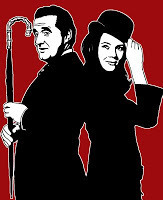 Rupert Hood is in distinguished company.
Rupert Hood is in distinguished company.And, if the series continues, you ain’t seen nothing yet.
To quote John Steed, “Mrs Peel, we’re needed.”
You certainly are. We need fast-moving thrillers peopled with engaging characters, drawn from the world of espionage, with an edge of fantasy and humour.
You’re needed now more than ever.
(PS: Since the geniuses at Google have redesigned Blogger it is now seems to be physically impossible to attach links to images, so thank you to the following sites who provided the images here: the wonderfully named Starlet Showcase, and Die Bilderwumme who created the lovely colour pic of Patrick Macnee and Diana Rigg.)
Published on October 21, 2012 04:49
October 14, 2012
Rupert Hood Strikes Again
Yes folks, Rupert Hood is back.
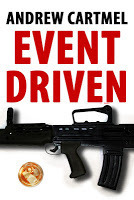
What's that you say? You don't know who Rupert Hood is? Good lord, then you need to hasten along and buy his first adventure, read it, and then get back to me.
In fact, if you hasten hastily enough, you don't even need to buy it. It's available today on free download. My wily publisher believes this will boost the sales of the new book.
I certainly hope so because the new book, Event Driven, is a giant leap forward for Rupert Hood, everybody's favourite secret agent masquerading as an estate agent. (Well okay, my favourite)
You see Operation Herod, the first book was written about three years ago.
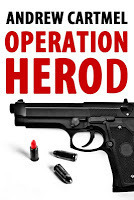 I sat down to write a high octane espionage thriller with an interesting villain and some memorable action set pieces. Me being me, it also had a distinct comic edge.
I sat down to write a high octane espionage thriller with an interesting villain and some memorable action set pieces. Me being me, it also had a distinct comic edge.
The book got me an agent — indeed one of the top agents in the country (hi, Julian) but despite his heroic efforts he couldn't win a publishing deal for the book. He was as frustrated as I was. The difficulty seemed to be that no one could grasp the notion of a thriller with some humour in it.
I particularly cherish one email he sent, updating me on the latest response: "Boring rejection, sadly typical of feeble minded editors."
Fast-forward three years. A far from feeble minded editor at a new e-publishing house, Endeavour Press, contacted me to see if I had any unpublished material they could look at. Indeed I did. And so Operation Herod saw the light of day.
However, I hadn't been idle in those intervening years. I'd written three (count 'em) other books. You'll be hearing more about those shortly.
 But the crucial thing is this: writing is a craft that you learn by doing. You improve through practise. I am a considerably better writer now thanks to the experience of fashioning those other novels.
But the crucial thing is this: writing is a craft that you learn by doing. You improve through practise. I am a considerably better writer now thanks to the experience of fashioning those other novels.
Which is why Event Driven is more fun than Operation Herod and a superior piece of work. At least I think so.
And so does my publisher and my editor. My friend Ben will think so too, when he reads it.
Far from being the difficult second novel it was a sheer pleasure to write, and I'm delighted to see it out there. the only difficult thing was getting the cover right (I loved the cover for Operation Herod).
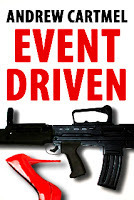 I've included various versions of prospective cover designs here for your consideration. My personal favourite? The strongest, graphically speaking, is definitely the one with the red shoe on it which is the work of my friend the brilliant designer Peri Godbold. Sadly it wasn't considered quite butch enough.
I've included various versions of prospective cover designs here for your consideration. My personal favourite? The strongest, graphically speaking, is definitely the one with the red shoe on it which is the work of my friend the brilliant designer Peri Godbold. Sadly it wasn't considered quite butch enough.
What's my reaction to the final choice?
Well, I'm a little concerned that people will think I'd put ice cubes in a glass of good single malt whisky. James Bond would never approve.
Neither would Rupert Hood.


What's that you say? You don't know who Rupert Hood is? Good lord, then you need to hasten along and buy his first adventure, read it, and then get back to me.
In fact, if you hasten hastily enough, you don't even need to buy it. It's available today on free download. My wily publisher believes this will boost the sales of the new book.
I certainly hope so because the new book, Event Driven, is a giant leap forward for Rupert Hood, everybody's favourite secret agent masquerading as an estate agent. (Well okay, my favourite)
You see Operation Herod, the first book was written about three years ago.
 I sat down to write a high octane espionage thriller with an interesting villain and some memorable action set pieces. Me being me, it also had a distinct comic edge.
I sat down to write a high octane espionage thriller with an interesting villain and some memorable action set pieces. Me being me, it also had a distinct comic edge.The book got me an agent — indeed one of the top agents in the country (hi, Julian) but despite his heroic efforts he couldn't win a publishing deal for the book. He was as frustrated as I was. The difficulty seemed to be that no one could grasp the notion of a thriller with some humour in it.
I particularly cherish one email he sent, updating me on the latest response: "Boring rejection, sadly typical of feeble minded editors."
Fast-forward three years. A far from feeble minded editor at a new e-publishing house, Endeavour Press, contacted me to see if I had any unpublished material they could look at. Indeed I did. And so Operation Herod saw the light of day.
However, I hadn't been idle in those intervening years. I'd written three (count 'em) other books. You'll be hearing more about those shortly.
 But the crucial thing is this: writing is a craft that you learn by doing. You improve through practise. I am a considerably better writer now thanks to the experience of fashioning those other novels.
But the crucial thing is this: writing is a craft that you learn by doing. You improve through practise. I am a considerably better writer now thanks to the experience of fashioning those other novels.Which is why Event Driven is more fun than Operation Herod and a superior piece of work. At least I think so.
And so does my publisher and my editor. My friend Ben will think so too, when he reads it.
Far from being the difficult second novel it was a sheer pleasure to write, and I'm delighted to see it out there. the only difficult thing was getting the cover right (I loved the cover for Operation Herod).
 I've included various versions of prospective cover designs here for your consideration. My personal favourite? The strongest, graphically speaking, is definitely the one with the red shoe on it which is the work of my friend the brilliant designer Peri Godbold. Sadly it wasn't considered quite butch enough.
I've included various versions of prospective cover designs here for your consideration. My personal favourite? The strongest, graphically speaking, is definitely the one with the red shoe on it which is the work of my friend the brilliant designer Peri Godbold. Sadly it wasn't considered quite butch enough.What's my reaction to the final choice?
Well, I'm a little concerned that people will think I'd put ice cubes in a glass of good single malt whisky. James Bond would never approve.
Neither would Rupert Hood.
Published on October 14, 2012 03:32
October 7, 2012
Writers and Directors
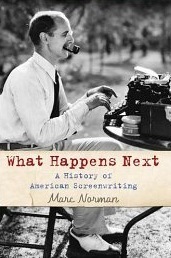 I love screenwriting. I love writing scripts, reading them, and reading about them — and the screenwriters behind them.
I love screenwriting. I love writing scripts, reading them, and reading about them — and the screenwriters behind them.So finding this book was like Christmas coming early. Weighing in at nearly 500 pages it is a big, juicy read devoted entirely to the screenwriting contingent in Hollywood.
And, best of all, it is written by a screenwriter. And a major one at that. Marc Norman's Oklahoma Crude is now pretty much forgotten, but at the time the script sold for a record sum.
More recently his screenplay for Shakespeare In Love won an Oscar — admittedly after a rewrite by Tom Stoppard.
But, as Andrew Kevin Walker (Seven) remarked of a similar experience on Sleepy Hollow, if you're going to be rewritten, that's the guy you want to be rewritten by.
Anyway, Marc Norman's splendid What Happens Next is a feast of fact, opinion and anecdote.
And, not unexpectedly, a lot of the book is devoted to the, ahem, tension between writers and directors about who is really responsible for creating a movie. In particular the mendacious "auteur" theory can be seen coming over the hill in the 1950s like the Chinese army launching an attack during the Korean police action.
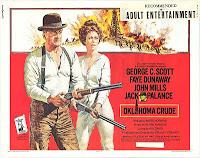 Just to give one example, Frank Capra directed nine classic films written by Robert Riskin. But as soon as Riskin was safely dead Capra made a massive credit grab, claiming he was the sole author of his output. Marc Norman writes that Capra "seized the newly hatched auteur theory like someone clutching a governor's reprieve."
Just to give one example, Frank Capra directed nine classic films written by Robert Riskin. But as soon as Riskin was safely dead Capra made a massive credit grab, claiming he was the sole author of his output. Marc Norman writes that Capra "seized the newly hatched auteur theory like someone clutching a governor's reprieve."A supplementary example of this kind of behaviour which comes to mind is Michael Winner and
Ah, well. What Happens Next is a great read and a must for anyone interested in screenwriting. It is particularly strong about the evolution of the screenplay in the first days of film. Towards the end of the book Marc Norman unfortunately glosses over more recent developments.
If he'd gone into detail, I suppose the book would have been twice as long.
But I, for one, would have been delighted to read a thousand pages on the subject. Any chance of a sequel, Marc?
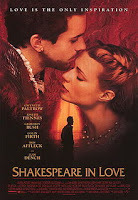 Before I close, as a world class nit-picker I need to point out a few small solecisms in the text:
Before I close, as a world class nit-picker I need to point out a few small solecisms in the text:Leon Uris couldn't have been famous for writing Exodus when Nicholas Ray was looking for a screenwriter for Rebel Without a Cause, because annoying Exodus was published in 1958 and Rebel Without a Cause was released in 1955.
Roger Corman's The Trip is not a biker flick (not a motorcycle in sight).
Simon Moore's brilliant television serial Traffik was was written for Channel 4, not the BBC — but really, that hardly matters since Marc Norman mentions it while giving Simon Moore proper credit for his contribution to the Oscar winning film Traffic.
There is a rather snooty review of What Happens Next which you can read if you want to know more.
But I suggest you just buy the book.
(Incidentally, the writer depicted on the cover is Ogden Stewart and his fascinating story makes him a particularly apt choice.)
Published on October 07, 2012 02:22
September 30, 2012
Killing Them Softly: George V. Higgins and Life After Death
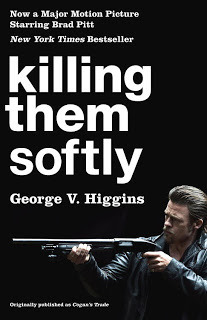 There is this to be said for being a good writer. You get a shot at life after death.
There is this to be said for being a good writer. You get a shot at life after death.I realised this quite forcefully as I sat and watched the new Brad Pitt crime movie Killing Them Softly.
The trailers for this had looked promising, and I'd been mildly looking forward to seeing it.
But then I discovered it was based on the novel Cogan's Trade by George V. Higgins, and mild anticipation turned to mild apprehension.
Because Higgins is a hero of mine.
Now largely forgotten, he's a major figure in American crime fiction, on a par with Charles Willeford and Elmore Leonard. Indeed, Higgins' dialogue-led prose style, in which characterisation and plot are largely delivered by letting his characters speak for themselves, demotically and hilariously and at length, was a major influence on Elmore Leonard's later work.
Higgins' raw, authentic, profane and often very funny dialogue was brilliantly written and represented a kind of blue collar American version of Pinter. It was a huge influence on David Mamet.
Higgins first novel The Friends of Eddie Coyle created quite a splash and was turned into an excellent film by Peter Yates and Paul Monash. It was followed by The Digger's Game and Cogan's Trade.
When I learned Andrew Dominick's new film was based on Cogan's Trade I braced myself for a disaster. I was very protective of Higgins brilliant work which, like Elmore Leonard's, can so easily end up disastrously botched when adapted for the cinema.
I needn't have worried. Killing Them Softly is magnificent. It's a masterpiece. It's a movie. Yes, it's a magnificent, mean and moody movie masterpiece.
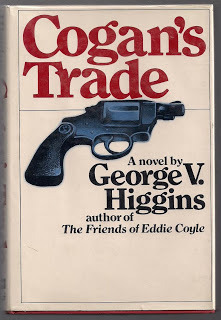
And it's utterly true to the George V. Higgins novel. When I first saw it (I've seen it twice now and this week I mean to make it a hat trick) I marvelled at how carefully they'd preserved Higgins' superb dialogue.
All power to Andrew Dominik, the New Zealand director and screenwriter who adapted it so beautifully. (His last film was the haunting and elegiac Assassination of Jesse James, a sort of Terence Malick western.)
I was still shaking my head in wonder at how faithful Dominick had been to the source material when I dug out my old paperback copy of Cogan's Trade and started re-reading it.
And I made this extraordinary discovery.
The movie wasn't that close to the book after all.
Yes, it had absolutely preserved the spirit and flavour of Higgins' original. It had captured the essence of it.
But Andrew Dominick has been ingeniously discriminating and selective, adding his own material which is absolutely in keeping with Higgins' book.
His feat is even more impressive than I thought.
Even more power to Andrew Dominick.
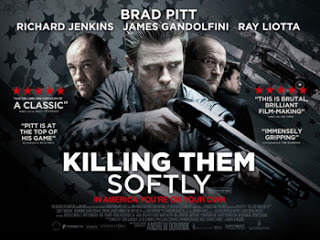 I hope the movie is a huge hit. It certainly stands the chance of finding a large audience thanks to the presence of Pitt. And it has a large overlap with popular urban organised-crime dramas like The Sopranos or the films of Scorsese (and some canny casting reinforces these connections).
I hope the movie is a huge hit. It certainly stands the chance of finding a large audience thanks to the presence of Pitt. And it has a large overlap with popular urban organised-crime dramas like The Sopranos or the films of Scorsese (and some canny casting reinforces these connections).But some people find it too downbeat, bleak and talky. A couple sitting behind me walked out after the scene with James Gandolfini and the hooker in the hotel room.
One of the best scenes in the movie, incidentally.
So you should rush and see this terrific movie while you can.
And then read some George V. Higgins. He wrote a long string of novels, all of which have merit. But I still think the first three are perhaps the strongest, and certainly the best place to start.
Thanks to Andrew Dominick's dazzling film, George V. Higgins, who died in 1999, lives again.
Published on September 30, 2012 02:25
September 23, 2012
Cornell Woolrich: The Missing Link Between Poe and Highsmith
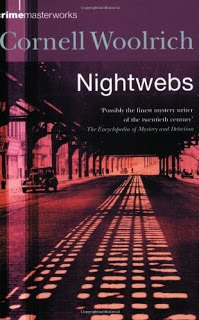 It's not often that I have a literary revelation, so when I do I like to share it with you.
It's not often that I have a literary revelation, so when I do I like to share it with you. I recently picked up a copy of the Cornell Woolrich anthology Nightwebs. It was a volume in the terrific Crime Masterworks (or 'Rime Masterworks' as this rather poorly cropped image has it) series from Orion in 2002.
Like everyone else I'm familiar with Woolrich chiefly thanks to his story 'It Had to Be Murder' which was adapted by Alfred Hitchcock and screenwriter John Michael Hayes as the classic Rear Window.
Not surprisingly, there's another anthology of his vivid, vicious crime stories available with that title, which I've also read and would recommend — especially if you can get the version with the lovely Steranko cover shown here.
But back to Woolrich (who also wrote under a number of pseudonyms, notably William Irish).
There is an almost diseased, pathological quality to his writing which can convey a powerful sense of dread. He is also brilliant at generating suspense. The fact that his prose, characters, and plotting veer from superb to ludicrous somehow doesn't seem to undermine this at all.
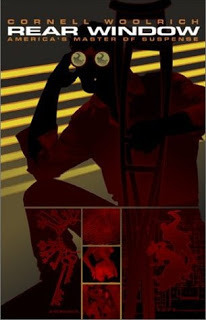 In particular, his view of the world as a malign box of tricks designed to torment the protagonist, and the many grisly ways this can happen, reminded me strongly of both his esteemed predecessor Edgar Alan Poe and his brilliant successor Patricia Highsmith.
In particular, his view of the world as a malign box of tricks designed to torment the protagonist, and the many grisly ways this can happen, reminded me strongly of both his esteemed predecessor Edgar Alan Poe and his brilliant successor Patricia Highsmith. Evidence? Well, off the top of my head I'd suggest the Poe story 'The Imp of the Perverse'. It seems to me that this is pure Woolrich in its bent and tortured psychology.
And as for Patricia Highsmith, try Ripley Under Water. Not the best Ripley book. But the scene where Ripley's persecutor dredges up the body of a man Ripley murdered, and dumps it on his doorstep, could have come straight out of Woolrich.
Is there any evidence of Poe influencing Woolrich, and Woolrich in turn influencing Highsmith?
Well, I haven't scoured the biographies of Woolrich, but I think we can assume that as one of America's leading crime and suspense writers, he would have been acquainted to some degree with the legendary father of the genre. It isn't too much of a stretch.
On the other hand, I have scoured the biographies of Highsmith — or at least one of them, the excellent Beautiful Shadow by Andrew Wilson — and found no mention of Woolrich. But I would be surprised if Highsmith didn't know his stories. She certainly could have seen some of the movies adapted from them and, since Hitchcock did a version of her own novel Strangers on a Train, Rear Window could hardly have escaped her attention.
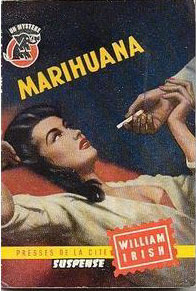
There is a tendency for Patricia Highsmith to be claimed as a highbrow artist. But let's not forget that she read (and indeed wrote for) comic books. I can easily see her with her nose in a pulp magazine, reading the latest Woolrich epic, avidly flipping pages.
But if anyone knows for sure... do get in touch.
Back to Woolrich and Nightwebs (odd title, effective and poetic, but where did it come from? Not any of the stories in the book). This is a high calibre collection and a good place to start if you don't know Woolrich. It also features first rate supplementray material, in the shape of an indepth introduction and afterwords for each story by Francis M Nevins.
But Woolrich's power is so often dependent on surprise that I advise you not to read any of this stuff until you read the stories themselves.
And, as for the stories themselves, there are many which deserve discussion.
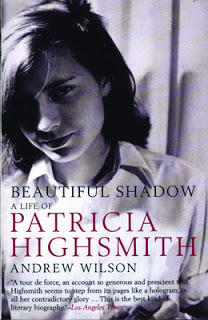 But I'll restrict myself for now to the first one in the book. Graves for the Living (1937) is an EC horror comic of a story. It is jarring, lurid pulp. But the weirdest thing is... it bears an almost eerie resemblance to Arhtur Schnitzler's highly literary Traumnovelle, which was adapted by Stanley Kubrick and Frederic Raphael as Eyes Wide Shut.
But I'll restrict myself for now to the first one in the book. Graves for the Living (1937) is an EC horror comic of a story. It is jarring, lurid pulp. But the weirdest thing is... it bears an almost eerie resemblance to Arhtur Schnitzler's highly literary Traumnovelle, which was adapted by Stanley Kubrick and Frederic Raphael as Eyes Wide Shut. Consider the similarities. Both deal with men who find themselves emeshed with a strange cultish group who hold ritualistic secret meetings and seem omni present and menacing.
Both involve the groups passing threatening notes to the hero to remind him he is under observation. In both the hero attends a masked gathering of the cult/group where he is threatened with (deadly?) punishment and is only saved thanks to a woman.
And in both of them, the woman offers herself up for punishment in place of the hero.
It would have been a pretty good trick for Woolrich to have seen the Kubrick film — he died in 1968, some 21 years before it was released. But he could well have been acquainted with Schnitzler's novella, published in 1926.
Anyhow, thanks for listening.
Do visit the great Cornell Woolrich Cover Gallery.
Published on September 23, 2012 01:05



